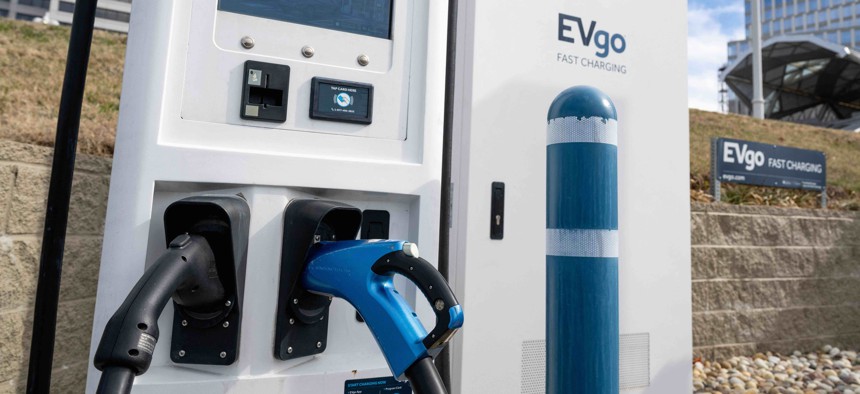In national race to build EV chargers, a few states emerge as big winners

Saul Loeb/AFP via Getty Images
State policy, the electric grid and business considerations can all determine how many public charging stations a state’s residents will see.
There are more than 2.5 times as many publicly available electric vehicle chargers today as there were three years ago, slightly outpacing the growth of EVs on the roads during that time. But the rollout has been far from even.
California leads the country in the sheer number of public chargers added. With nearly 9,000 coming on line in the last three years, California nearly tripled the number of EV chargers installed in New York, which saw the second most added.
Florida, Massachusetts, Texas, Washington, Colorado, Maryland, Ohio and Michigan rounded out the top 10, according to industry data from HERE Technologies, a location data platform, using its ChargePoint API.
The top 10 states accounted for more than half of the new chargers installed in the last three years.
Twelve states, by comparison, added fewer than 200 chargers during that time. Alaska had the fewest, with 54 chargers rolled out. But it also started with just two chargers in 2020, the lowest of any state.
On a per-capita basis, Vermont topped the list of new chargers added, followed by Washington, D.C., Maine, Massachusetts, Colorado, Hawaii, California, Maryland, Oregon and Rhode Island.
The race to build out a national charging network is crucial, because prospective electric vehicle owners say the main barrier keeping them from going electric is not having enough places to plug in the cars. State and local officials can help speed the transition to EVs by making sure that more chargers are built in their area, said Ronak Amin, global product marketing manager for HERE Technologies.
“In the early days, everybody charged at home,” he said. “But now you have customers walking in who want to make their EV their primary vehicle. If they buy that Cadillac Escalade, they want to take it on a long trip; they don’t want to just keep it in the area they live in. So now they’re more dependent on public charging out of the house.”
The location of new chargers depends on a lot of factors, some of which government officials can control and many that they cannot.
“Infrastructure is the big technical challenge, because there’s no real near-term way to solve that,” Amin said. “That takes a long time.” An existing electric grid that’s already robust with lots of generating and transmission capacity, for example, makes it easier to build EV stations in Florida than in New Mexico or Alabama.
But state officials can push forward in how they roll out the National Electric Vehicle Infrastructure, or NEVI, program to build a national network of chargers along critical highways. For example, Amin pointed to efforts by Pennsylvania officials to get local businesses like gas stations near these roadways to contribute to the 20% match to secure federal funding.
Charging companies will concentrate on areas where EVs are already popular, especially in urban areas, but they are trying to expand to meet growing demand, too. Tesla, for example, built out its network of fast chargers in places like Arizona and Nevada after its EVs had became so popular in California.
“Unfortunately,” Amin said, “the Tesla network is not going to be able to service all of the vehicles that we need to come online in the next couple of years. If we can get a rival network that’s equally as reliable as Tesla, equally as accessible and has a common standard, then I think that’s necessary.”
That’s why seven major automakers announced last week that they would work together to build a national network of fast chargers to compete with Tesla’s existing system. General Motors, BMW, Honda, Hyundai, Kia, Mercedes and Stellantis said they would add 30,000 new quick-charging plugs in urban areas and along major highways in the U.S. and Canada. They want to ease “range anxiety” among potential customers who worry about not being able to find a charging station.
Notably, the new consortium of automakers will be able to service both vehicles with the current industry-standard plugs and with Tesla-style plugs, which more automakers are adopting. Other charging networks plan to add Tesla-style chargers as well.
The operators of charging networks see the developments as positive, Amin said. “Just as a Ford can now charge at a Tesla station, that same Ford can charge at a Blink or EVGO station, because it has the [Tesla-style plug] and we supply that now,” he said. “We’re not closing the opportunity pool here.”
That includes the states building out charging corridors under the federal NEVI program, Amin added.
“The $5 billion to get agnostic chargers put across the U.S. around state highways ultimately was a good idea,” he said, even if it leads to some redundancy. “We just need more charging in general. There’s not going to be as much redundancy as we think. There are still going to be customers [even of proprietary networks] who are still, in a pinch, going to need a public charger.”
Daniel C. Vock is a senior reporter for Route Fifty based in Washington, D.C.
NEXT STORY: Passions run high over speed limits, but data is hard to come by






